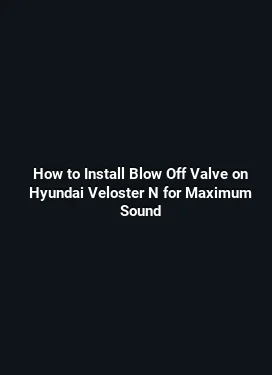The Ultimate Clutch and Flywheel Guide for Street and Strip Applications
Understanding Clutch Fundamentals

At the core of any manual transmission setup lies the clutch, a modular system that couples the engine’s power to the transmission and ultimately to the wheels. A clutch assembly comprises the pressure plate, clutch disc, release bearing, and the flywheel. The interaction among these components determines how smoothly power is transmitted, how quickly you can engage gears, and how the drivetrain responds under load. For street and strip applications, understanding the balance between grip, pedal feel, and durability is essential, because daily driving demands smooth launches and consistent performance, while drag setups call for repeatable, high-traction engagement.
Clutch engagement is defined by the contact between clutch disc and flywheel. A higher engagement pressure or a more aggressive friction material can translate into quicker throttle response but may sacrifice smoothness. Conversely, a softer engagement profile improves driveability but might limit maximum traction on high-horsepower builds. Selecting the right combination requires evaluating engine torque curves, vehicle weight, gear ratios, tire compliance, and intended driving style. In street use, a reliable, moderate-traction clutch that preserves pedal feel is often preferred, while strip-focused builds tend to favor stiffer springs and material choices that minimize slippage at high torque.
Key Components and How They Interact

The flywheel stores rotational energy and provides a friction surface for the clutch disc. A heavy flywheel improves stall characteristics and throttle response at low speeds, which is beneficial in street driving for predictable launches. However, heavier flywheels can dampen engine responsiveness at higher RPM and reduce overall engine response in quick shifts. Lightweight flywheels reduce rotating mass and improve engine response, making rev-matching and gear changes snappier. On the downside, very light designs can increase vibration and reduce driveability if not paired with a balanced rotating assembly or proper engine harmonics control.
Clutch discs come in different constructions: organic, ceramic, semi-metallic, and performance multi-plate designs. Organic materials are common for daily driving, offering smooth engagement and durability for moderate power levels. Ceramic or semi-metallic discs provide higher friction and thermal stability, which is beneficial in high-torque conditions but can introduce more pedal effort and chatter at low speeds. For strip applications, a multi-plate clutch or a ceramic-backed disc can handle sustained high torque and repeated launches, albeit with greater complexity and cost. The pressure plate’s spring rate and diaphragm design further influence engagement feel and clamping force, shaping how the clutch behaves during take-off and under hard shifting.
Flywheel Design Variations and Their Impact
Flywheels come in several designs, each with unique benefits and trade-offs. A standard cold-rolled, steel flywheel provides a robust, cost-effective option for daily-driving enthusiasts who occasionally track their car. For performance-oriented builds, a lightweight aluminum flywheel reduces rotating mass and improves throttle response, but it can increase engine vibration and place more demand on the transmission and balance procedures. A fractional or stepped flywheel can help tune torque delivery, enabling a more aggressive launch without drastically altering overall operating characteristics. The choice between a driven-surface finish, tooth geometry, and ring gear design also affects starter engagement reliability and gear train smoothness during cold starts.
Balancer considerations are crucial when selecting a flywheel. A properly balanced flywheel reduces harmonic vibrations that can travel through the crankshaft and bearings, extending component life and maintaining drive quality. In performance builds, a properly balanced rotating assembly reduces the risk of fatigue under high RPM and torque. If upgrading the flywheel, it is common to also consider matching a clutch with a higher clamping force or a different friction material to preserve engagement behavior while handling increased horsepower and torque figures.
Material Science and Thermal Management
Clutch and flywheel materials must withstand repeated heating cycles without glazing or glazing-induced slip. Thermal capacity becomes a limiting factor on the street-legal machine that regularly practices full-throttle starts, hill starts, or aggressive shifts. Ceramic and sintered materials resist high temperatures better than standard organics, but they can exhibit more aggressive engagement characteristics when cold. To mitigate this, many setups use dual- or multi-surface designs that blend the best traits of different materials. Thermal management also includes ensuring adequate airflow to the clutch area and using upgraded release bearings to maintain consistent pedal feel under load. In drag setups, the emphasis shifts toward maintaining friction integrity at sustained high RPM and torque, often requiring specialized surface finishes and higher clamping force from the pressure plate.
Street vs Strip: Selecting the Right Clutch Profile
Street-driven vehicles prioritize a balance between daily comfort and confident performance. A clutch with smooth engagement, moderate pedal effort, and reliable longevity suits long commutes and spirited weekend drives alike. In strip-oriented applications, the goal shifts toward minimizing slippage under extreme torque, ensuring consistent releases for quick quarter-mile times, and withstanding repeated high-load launches without glazing the disc. The ideal setup often blends a high-friction material with a pressure plate tuned for aggressive engagement while maintaining feasible pedal effort for traffic situations. Tire choice, gearing, and drive-train layout must be considered in tandem with the clutch profile to deliver predictable launches and efficient shifts.
Fresh clutch and flywheel pairing is essential after significant power additions. When power levels rise beyond the original design, increasing clamping force and upgrading to higher-friction materials become common. One practical approach is to start with a slightly oversized clutch for the extra torque, then tune the driving technique to manage heat and wear. For example, a street car with a modest power upgrade may benefit from a slightly stiffer engagement, while a dedicated drag car will often benefit from a more aggressive clamp and a lightweight flywheel to maximize response. The right balance depends on the engine’s torque band, the transmission’s gearing, and the driver’s preference for pedal feel versus launch aggressiveness.
Torque, RPM Range, and Load Considerations
The maximum useful torque and the engine’s torque rise rate determine the clutch’s suitability for a given build. A steep torque curve with high peak torque requires a clutch capable of withstanding peak forces without slipping. The RPM range in which the vehicle operates most of the time also matters: high-rpm launches benefit from robust friction materials and strong clamping, while low-rpm street driving benefits from softer engagement characteristics that avoid abrupt engagement and wheel hop. Gear ratios influence how often the clutch must handle surge loads—tight gear spacings in drag racing can demand faster, more consistent clutch action than a street-car cruising scenario.
Durability and Reliability: Materials, Heat, and Wear
Durability hinges on how well the system tolerates heat, friction, and repeated cycling. In high-horsepower builds, heat management becomes a limiting factor, so choosing friction materials with excellent thermal stability and consistent performance under repeated cycles is critical. Proper lubrication for the release bearing and a correctly adjusted hydraulics or cable mechanism help avoid premature wear. Regular inspection of the flywheel surface for glazing or hot spots and checking the clutch alignment during installation contribute to long-term reliability. Less obvious but equally important is ensuring the transmission’s input shaft and pilot bearing are in good condition to prevent parasitic wear that can degrade clutch performance over time.
In drag-specific configurations, it is common to employ a clutch with a more aggressive surface design and a flywheel tailored for rapid heat dissipation. The priority here is repeatable engagement across multiple runs with minimal fade. Street-oriented setups may favor slightly more forgiving friction surfaces and a flywheel designed to smooth torque delivery at street velocities, especially on rough surfaces or during stop-and-go traffic. The decision matrix includes rotor harmonic balance, drivetrain alignment, and the quality of the clutch’s spline interface to minimize slip and maximize transfer of power to the wheels.
Installation, Maintenance, and Set-Up Tips
Proper installation is the foundation of reliable clutch performance. The process begins with cleaning all mating surfaces, bedding the clutch according to the manufacturer’s guidelines, and ensuring the transmission bell housing is free of debris. When bedding a new friction surface, follow a controlled routine that gradually builds heat and pressure to avoid glazing. This often involves a series of controlled starts and light to moderate throttle applications to gradually seat the surface and achieve even contact across the friction material.
Maintenance is not a one-off event. Periodic inspection of the release bearing, pilot bearing, and input shaft condition is essential to prevent sudden failures. It is also prudent to check for heat marks on the flywheel and inspect for cracks or scoring. If you notice slipping, chattering, or a change in pedal feel, it may indicate wear or misalignment that warrants investigation. A balanced rotating assembly is critical; if a new flywheel is installed, ensure the balance is rechecked to prevent vibration-induced wear and noise that can harm drivetrain life. Regularly verify clutch alignment during installation and after any component replacement to ensure even load distribution across the flywheel surface.
Driving Techniques for Maximizing Clutch Life and Performance
One practical approach to maximize clutch life is to use smooth, progressive throttle input during launches, especially on wet or uneven surfaces. Gentle throttle modulation reduces instantaneous torque spike, lowering the risk of wheel spin and clutch slip. Downshifting with rev-matching helps maintain consistent engine speeds and reduces shock loads on the drivetrain, contributing to longer clutch life. In strip contexts, practice consistent launch procedures that minimize clutch slip while achieving repeatable times. Techniques such as staged launches with steady clutch engagement and controlled throttle application can improve consistency and reduce wear on friction surfaces.
Another consideration is tire choice and chassis setup. High-traction tires can dramatically alter the demand placed on the clutch during launch. If the tires provide much more grip than originally anticipated, a thoughtful adjustment to the clutch’s clutching force or a slightly different pressure plate can help maintain stability through the initial engagement. Likewise, ensuring the transmission and engine mounts are in good condition reduces unwanted movement during 0-60 transitions, helping the clutch remain within its intended engagement window during launches and gear changes.
Performance Upgrades and Practical Modifications
Performance-minded owners often explore combinations that optimize power delivery without compromising daily drivability. Pairing a lightweight flywheel with a high-friction clutch can sharpen throttle response, enabling quicker power transfer once the engine reaches the desired RPM. For street and strip applications, consider a clutch with a well-suited friction material for the expected operating temperature range and a flywheel design that aligns with the engine’s torque characteristics. Upgrades like a hydraulic release system can improve pedal feel and bite consistency, while a properly tuned clutch line reduces pedal effort and enhances modulation during launches.
Additionally, attention to ancillary systems such as the starter motor, ring gear quality, and crankshaft balance is essential when pursuing higher power levels. A robust ring gear that is compatible with the engine’s starter can prevent issues during cold starts and ensure reliable engagement with every crank. Engine builders often emphasize balanced assemblies to minimize harmonics that could amplify drivetrain vibrations, particularly when upgrading to lightweight flywheels or aggressive friction materials. All these components work together to deliver predictable behavior from idle to redline and through the shift sequence.
Common Failures and Troubleshooting
Clutch slipping, chattering, or inconsistent engagement are common symptoms of a mismatch between engine torque and clutch capacity. Slippage often indicates insufficient clamping force or an inappropriate friction material for the power level. Chatter can arise from glazed surfaces, improper bedding, or misalignment. In strip-oriented setups, high-frequency engagement can exacerbate wear on the spline interface; regular inspection of spline wear is advisable. A harsh or inconsistent pedal feel may signal hydraulic or bearing issues, requiring inspection and potential replacement of the release bearing or hydraulic hardware.
To minimize downtime and extend component life, adopt a proactive maintenance schedule that includes inspection after heavy track days, regular resistance tests for the release bearing, and confirmation of proper alignments. If you notice abnormal vibrations or noise that persists after installation, suspending use until diagnosis ensures the longevity of both the clutch and the flywheel. Understanding and addressing these issues early helps preserve performance and reduces the risk of in-race failures.
Choosing the Right Setup for Your Vehicle
Every vehicle is unique, and the optimal clutch and flywheel pairing depends on engine displacement, torque, weight, gearing, and driving objectives. A practical approach begins with cataloging goals: daily usability, weekend track use, or dedicated drag racing. From there, evaluate whether a heavier or lighter flywheel aligns with your torque curve and how much pedal effort you are willing to tolerate. The selection process should also consider the clutch’s overall lifespan under the expected power levels, the cost of replacement, and the ease of installation. Engaging a reputable professional for precise balancing and fitment checks ensures that the setup integrates seamlessly with the rest of the drivetrain.
In summary, the best clutch and flywheel combination for street and strip blends engagement quality, durability, and throttle responsiveness. It requires thoughtful consideration of materials, balance, and the engine’s torque behavior. A well-chosen pairing translates to smoother starts, confident shifts, and reliable performance across the RPM spectrum, whether cruising city streets or staging on a quarter-mile track. Frequently Asked Questions






